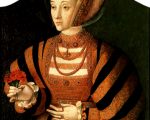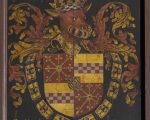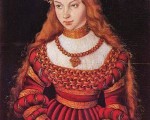
In today’s Claire Chats, I finish our series on Anne of Cleves by looking at her life following the annulment of her marriage to Henry VIII until her death in July 1557.
[Read More...]
In today’s Claire Chats, I finish our series on Anne of Cleves by looking at her life following the annulment of her marriage to Henry VIII until her death in July 1557.
[Read More...]
In today’s Claire Chat’s video talk, I look at Anne of Cleves’ marriage to Henry VIII and what happened between 6th January 1540, her wedding day, and 28th July 1540 when Henry VIII married Catherine Howard, his fifth wife.
[Read More...]
As tomorrow is the anniversary of Henry VIII’s fourth marriage, his marriage to Anne of Cleves, I thought I’d start a series of Claire Chats video talks on the marriage.
[Read More...]
Anne of Cleves was the fourth wife of King Henry VIII, but how much do you actually know about her? Test your knowledge and have some fun with our Sunday quiz on Anne – good luck!
[Read More...]
As today is the anniversary of the birth of Anne of Cleves on 22nd September 1515, I thought it was fitting to share some links to Anne of Cleves resources here on the Tudor Society site and to also share some recommendations for further reading.
[Read More...]
Today is the anniversary of the death of Anne of Cleves and to mark the occasion Claire looks at some texts associated with her.
[Read More...]
As today is the anniversary of the annulment of the marriage of Henry VIII and Anne of Cleves on 9th July 1540, I thought we would mark the occasion with an Anne of Cleves wordsearch as our Sunday fun.
Print it out, grab a drink and snack, and have a few minutes fun. It’s not too hard, I promise!
[Read More...]
Anne of Cleves was born on 22nd September 1515 in Dusseldorf to John III, Duke of Cleves, and his wife, Maria. Like Henry VIII’s first wife, Katherine of Aragon, Anne was born into a highly influential and politically active family. Her sister Sybille was married to the Elector of Saxony, and her brother, Wilhelm, became the future Duke of Cleves-Burg, and would be instrumental in negotiations regarding her future marriage.
Anne was born during the volatile reformation period, resulting in reforms against traditionalist Catholicism, which was spreading through western and northern Europe. Her mother has been described as a conservative Catholic, however, her sister Sybille’s husband was a renowned Lutheran, often given the epithet ‘champion of the reformation’, and a good friend of its founder, Martin Luther. Anne was originally intended to be married into the House of Lorraine when she was eleven in 1527. There were numerous negotiations regarding the union, but nothing was cemented, and by 1535 all official wedding discussions had essentially been rejected, leaving the desirable duke’s daughter available on the European marriage market. Henry VIII and his council were searching for a new wife after the death of Queen Jane Seymour in 1536, with rumours of a possible union with the Duchess of Milan. The French had aligned themselves to the Habsburgs and signed a ten-year truce in 1538 (although this never lasted), cementing a union between Europe’s two major Catholic powerhouses. Cromwell, Henry’s leading minister at the time, suggested a counter alliance with a Lutheran house in Germany, even though Anne’s family were relatively mild in their reformist views. Cromwell was aware that England was potentially vulnerable to a Franco-Habsburg invasion, and influenced the king that negotiating with the newly appointed Duke Wilhelm (Anne’s father had died in 1539) would be a successful diplomatic adventure, that would ensure the prosperity of England against foreign invasion.
[Read More...]
The full edition of our giant 62-page June edition of Tudor Life Magazine. It’s a fantastic look into Henry VIII’s fourth wife, Anne of Cleves.
[Read More...]
Thank you so much to our regular contributor, Heather R. Darsie, for writing this article on Anne of Cleves for us. Heather is working on a biography of Anne at the moment and is researching her using the German archives.
Anna von Kleve, known to English speakers as Anne of Cleves, left her homeland in December 1539 to join her new husband, Henry VIII of England. The two had been married by proxy a couple of months earlier, in October. After Henry successfully negotiated the marriage alliance with Anna’s younger brother Wilhelm, Duke of Cleves since early 1538, there was the simple matter of getting Anna to England. But which way to take, a sea route or over land? Both options would take Anna through Imperial and French territory, which was no small matter at the time.
[Read More...]
Anna von Kleve, from the line of von der Marck (Germanic) or LaMarck (Francophone), fourth wife of Henry VIII and most commonly known as Anne of Cleves, is known to have shared the lineage of King Edward I of England with Henry’s other five wives. While an interesting anecdote, Edward I, or Edward Longshanks, Hammer of the Scots, died in 1307. In 1539, when Anna came to England to be Henry’s queen, she had many well-known powerful relations, distant though they were. Below, we will go through the genealogy of some of Anna’s royal connections.
[Read More...]
On this day in history, 22nd September 1515, Anna von Jülich-Kleve-Berg, or Anne of Cleves as we know her, was born near Düsseldorf. She was the second daughter of John III, Duke of Jülich, Cleves and Berg, an important German ruler, and his wife, Maria of Jülich-Berg.
[Read More...]
For Part II of the Annes of Cleves, we’ll learn a little bit more about Henry VIII’s fourth wife, Anne of Cleves; her niece, Anna of Cleves; and Anna, Duchess of Cleves. Throughout the article, I will address them as Anne, Anna of Cleves, and the Duchess, so as to help in understanding who is who.
Anne of Cleves, born in 1515 in Germanic territories of the Holy Roman Empire, married Henry VIII of England in 1540. Her marriage to the King lasted only about six months before he divorced her. Due to Anne’s congeniality, Henry settled a good income and several properties on Anne. She remained in England until her death in 1557, where she enjoyed a relationship with Mary I of England, who was only six months Anne’s junior, and with Elizabeth I of England. Elizabeth and Anne rode together in the chariot just after Mary I’s during Mary’s triumphant ride through London as the new queen. Sadly, Anne passed away just over a year before her other stepdaughter, Elizabeth I, become queen.
[Read More...]
The name “Anne of Cleves” conjures up thoughts of Henry VIII’s allegedly unattractive, unfashionable fourth wife. However, over the span of almost 200 years, there were five women known as “Anne of Cleves”. First, we will meet Anne of Burgundy, who by marriage became an Anne of Cleves. For purposes of this article, we will refer to her as “van Kleef.” Next, we will meet the daughter of Johann II of Cleves, aunt to the famous Henry VIII’s fourth wife. We will call her “von Cleve” throughout this article. Finally, we will quickly look into the early life of Anne of Cleves, the most well-known to the English-speaking world.
[Read More...]
Yesterday was the anniversary of the death of Anne of Cleves on 16th July 1557, so I thought it would be good to mark the occasion with an Anne of Cleves themed quiz. How much do you know about this Tudor queen consort? Test yourself with this fun quiz.
[Read More...]
After just over six months of marriage, on 9 July 1540, Anna von Kleve, more commonly known as Anne of Cleves, was divorced from Henry VIII of England. As part of her reward for acquiescing so easily to Henry’s request, she would forever after be known in England as the Daughter of Cleves and Henry’s sister, though she signed letters to her brother as “Anna, born Duchess of Cleves,” or a variation thereof.
Anna was gifted many properties, including Chelsea and Hever Castle, the childhood home of Anne Boleyn. Anna maintained a relationship not only with Henry but also with his daughters Mary and Elizabeth. Anna would go on to live the rest of her life in England before dying at the age of 41. She never returned to the Holy Roman Empire, parts of which comprised most of what we know today as Germany.
[Read More...]
Henry VIII’s six wives are as popular as ever. In the 2016 History Hot 100 recently compiled by BBC History Magazine, no less than four of the notorious Tudor king’s consorts featured. Perhaps, unsurprisingly, wife number two Anne Boleyn finished highest, at number 4. Katherine Parr came in at number 31, Katherine of Aragon at 36, and Anne of Cleves at 38.
Tudormania, as coined by a Guardian article, is pervasive. The general public and historians alike cannot get enough of the Tudors. But our obsession with this colourful dynasty, by and large, centres on a handful of characters that dominate films, novels and articles. This confinement of our focus is starkly revealed in the Hot 100: the top Tudor figures are, unsurprisingly, Elizabeth I, Henry VIII, Anne Boleyn and Thomas Cromwell.
[Read More...]
Sibylle von Kleve was born on 17 January 1512 and eventually became older sister to Anna von Kleve, more commonly known as Anne of Cleves or Henry VIII’s fourth wife, in 1515. Sibylle, the eldest of Maria von Julich-Berg’s children with Duke Johann von Kleve, was elevated to the station of Electress Consort through her marriage to Johann Friedrich I, the Elector of Saxony, in 1527.
As Electress of Saxony, Sibylle enjoyed a fruitful marriage with Johann Friedrich and had four sons, three of whom survived to adulthood. Sibylle was known as a great beauty, as can be seen from her engagement portrait by Lucas Cranach the Elder from 1526 (left hand portrait). Her long, golden-brown hair is loose and flowing about her shoulders. Lucas Cranach the Elder and his workshop would go on to produce many portraits of Sibylle and her family, including one finished in 1531, when Sibylle was 29. In the 1531 portrait of Sibylle (right hand portrait), we see that she likely plucked back her hairline, as was fashionable in the period as a high forehead showed that a woman was of noble bearing and intelligent.
[Read More...]
In today’s Claire Chats I look at the evidence regarding Henry VIII’s claims that Anne of Cleves was unattractive and the origin of the “Flanders Mare” label.
[Read More...]
Herzlichen Glückwunsch zum 500ten Geburtstag, Anna! Anna von Kleve, most widely known as Anne of Cleves or Henry VIII’s fourth wife, was born on either 201 or 22 September 1515. Anna was born in Düsseldorf, the second daughter out of four children. She lived at her father’s court until late 1539, when Anna moved to England to become Henry VIII’s fourth queen.
[Read More...]
Gloriana, Elizabeth I, is the famous Virgin Queen of England. She never took a husband. Much speculation has swirled around Elizabeth’s decision to remain single. Several tragic, if not traumatic, events are cited as reasons why Elizabeth chose not to marry.
Elizabeth was born on 7 September 1533. On 19 May 1536, when Elizabeth was not quite three years of age, her mother, Anne Boleyn, was beheaded by order of her father. Elizabeth, a precocious child, asked following the fall of her mother, “how haps it governor, yesterday my Lady Princess, today but my Lady Elizabeth?”. Elizabeth’s first step-mother, Jane Seymour, died of puerperal fever in 1537 only days after giving birth to Elizabeth’s little half-brother. Elizabeth was four years old. Katherine Howard, a cousin of Elizabeth’s on her mother’s side and Elizabeth’s third step-mother, was beheaded for high treason for her “dissolute life previous to her marriage” in February 1542. Elizabeth was eight years old.
[Read More...]